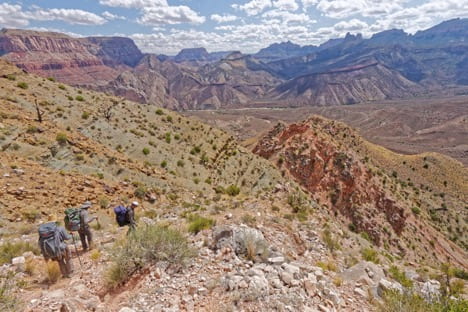JOURNEY TO THE DAWN OF SNOWBALL EARTH
By Greg Retallack
Director of the Condon Fossil Collection
 The museum’s Condon Fossil Collection is unusual among research collections in that it includes a comprehensive array of fossil soils. These ancient soils, or paleosols, represent snapshots of ecosystems across deep time, providing an especially long view of the relationships between climate and life on Earth.
The museum’s Condon Fossil Collection is unusual among research collections in that it includes a comprehensive array of fossil soils. These ancient soils, or paleosols, represent snapshots of ecosystems across deep time, providing an especially long view of the relationships between climate and life on Earth.
While paleosols have much to say about global warming, they can also reveal important clues about global cooling. One of the great mysteries of geological history is the chilly period dubbed Snowball Earth, which occurred around 700 million years ago. During this extreme cooling event, Earth’s oceans and land surfaces were covered with ice, while below-freezing temperatures and gale-force winds reached even the lowest latitudes.
But what factors drove this global deep freeze? This was the question that took me, along with several graduate students, on a summer 2019 trek into Nankoweap Creek in Grand Canyon National Park—an expedition supported through a generous grant from the museum’s Sandal Society. There, the horizontal rock layers that make the Grand Canyon famous are underlain by a thick sequence of rocks some 780 to 740 million years old. Known as the Chuar Group, these deeper rocks could hold important clues about the ecological conditions that led up to snowball Earth.

Other ice ages in the geological past may have been related to major events in the evolution of terrestrial ecosystems. For example, many scholars assert that the Permian-Carboniferous ice age, which occurred around 250 million years ago, was driven in part by the evolution and global expansion of land plants: The proliferation of trees, forests, and swamps would have contributed to a decrease in atmospheric carbon levels through increased terrestrial carbon storage and rock weathering.
If similar processes drove the onset of Snowball Earth, we should see evidence of novel carbon-consuming life forms and increased weathering in the fossil soils present in the Chuar Group. Over the course of our field trip, we sampled fossil soils from many localities within the rock group and transported them back to the lab. Our analyses are currently underway and will reveal the amounts of carbon dioxide present in the atmosphere as well as the degree of carbon sequestration in soils from the pre-Snowball period—offering a clearer picture of the degree of weathering and its role in regulating the planetary greenhouse effect.
Snowball Earth is a paleoenvironmental puzzle of the first order. The more we understand about the drivers behind this climate catastrophe, the better equipped we are to predict, and perhaps even prevent, climate catastrophes in the present and future.
NEXT: Time Travel with Barry Hughes
